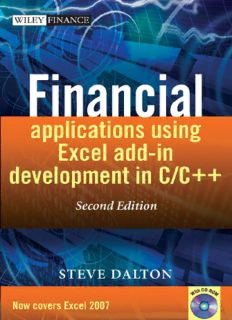
Financial applications using Excel add-in development in C-C++ PDF
Preview Financial applications using Excel add-in development in C-C++
Financial Applications Using Excel Add-in Development in C/C++ Second Edition of Excel Add-in Development in C/C++ Steve Dalton Financial Applications using Excel Add-in Development in C/C++ For other titles in the Wiley Finance Series please see www.wiley.com/finance Financial Applications Using Excel Add-in Development in C/C++ Second Edition of Excel Add-in Development in C/C++ Steve Dalton Copyright2007 JohnWiley&SonsLtd,TheAtrium,SouthernGate,Chichester, WestSussexPO198SQ,England Telephone(+44)1243779777 Email(forordersandcustomerserviceenquiries):cs-books@wiley.co.uk VisitourHomePageonwww.wileyeurope.comorwww.wiley.com AllRightsReserved.Nopartofthispublicationmaybereproduced,storedinaretrievalsystemor transmittedinanyformorbyanymeans,electronic,mechanical,photocopying,recording,scanningor otherwise,exceptunderthetermsoftheCopyright,DesignsandPatentsAct1988orunderthetermsofa licenceissuedbytheCopyrightLicensingAgencyLtd,90TottenhamCourtRoad,LondonW1T4LP,UK, withoutthepermissioninwritingofthePublisher.RequeststothePublishershouldbeaddressedto thePermissionsDepartment,JohnWiley&SonsLtd,TheAtrium,SouthernGate,Chichester, WestSussexPO198SQ,England,oremailedtopermreq@wiley.co.uk,orfaxedto(+44)1243770620. Designationsusedbycompaniestodistinguishtheirproductsareoftenclaimedastrademarks.Allbrand namesandproductnamesusedinthisbookaretradenames,servicemarks,trademarksorregistered trademarksoftheirrespectiveowners.ThePublisherisnotassociatedwithanyproductorvendormentioned inthisbook. Thispublicationisdesignedtoprovideaccurateandauthoritativeinformationinregardtothesubjectmatter covered.ItissoldontheunderstandingthatthePublisherisnotengagedinrenderingprofessionalservices.If professionaladviceorotherexpertassistanceisrequired,theservicesofacompetentprofessionalshouldbe sought. OtherWileyEditorialOffices JohnWiley&SonsInc.,111RiverStreet,Hoboken,NJ07030,USA Jossey-Bass,989MarketStreet,SanFrancisco,CA94103-1741,USA Wiley-VCHVerlagGmbH,Boschstr.12,D-69469Weinheim,Germany JohnWiley&SonsAustraliaLtd,42McDougallStreet,Milton,Queensland4064,Australia JohnWiley&Sons(Asia)PteLtd,2ClementiLoop#02-01,JinXingDistripark,Singapore129809 JohnWiley&SonsCanadaLtd,6045FreemontBlvd,Mississauga,ONT,L5R4J3,Canada Wileyalsopublishesitsbooksinavarietyofelectronicformats.Somecontentthatappears inprintmaynotbeavailableinelectronicbooks. LibraryofCongressCataloging-in-PublicationData Dalton,Steve. FinancialapplicationsusingExceladd-indevelopmentinC/C++/SteveDalton.—2nded. p.cm. Earliered.publishedundertitle:Exceladd-indevelopmentinC/C++:applicationsinfinance. Chichester:Wiley,c2004. Includesbibliographicalreferencesandindex. ISBN978-0-470-02797-4 (cloth/cd:alk.paper) 1.MicrosoftExcel(Computerfile)2.Business—Computerprograms.3.C(Computerprogramlanguage) 4.C++(Computerprogramlanguage)5.Computersoftware—Development. I.Dalton,Steve. Exceladd-indevelopmentinC/C++.II.Title. HF5548.4.M523D35 2007 005.54—dc22 2006036080 BritishLibraryCataloguinginPublicationData AcataloguerecordforthisbookisavailablefromtheBritishLibrary ISBN978-0-0470-02797-4 (HB) Typesetin10/12ptTimesbyLaserwordsPrivateLimited,Chennai,India PrintedandboundinGreatBritainbyAntonyRoweLtd,Chippenham,Wiltshire Thisbookisprintedonacid-freepaperresponsiblymanufacturedfromsustainableforestry inwhichatleasttwotreesareplantedforeachoneusedforpaperproduction. Contents Preface to Second Edition xvii Preface to First Edition xix Acknowledgements for the First Edition xxi Acknowledgements for the Second Edition xxiii 1 Introduction 1 1.1 Typographical and code conventions used in this book 1 1.2 What tools and resources are required to write add-ins 2 1.2.1 VBA macros and add-ins 3 1.2.2 C/C++ DLL add-ins 4 1.2.3 C/C++ DLLs that can access the C API and XLL add-ins 4 1.2.4 C/C++/C# .NET add-ins 4 1.3 To which versions of Excel does this book apply? 5 1.4 The future of Excel: Excel 2007 (Version 12) 5 1.4.1 Summary of key workbook changes 5 1.4.2 Aspects of Excel 2007 not covered in this book 6 1.4.3 Excel 2007 file formats 6 1.4.4 Compatibility between Excel 2007 and earlier versions 6 1.5 About add-ins 7 1.6 Why is this book needed? 8 1.7 How this book is organised 9 1.8 Scope and limitations 10 2 Excel Functionality 11 2.1 Overview of Excel data organisation 11 2.2 A1 versus R1C1 cell references 12 2.3 Cell contents 13 2.4 Worksheet data types and limits 13 2.5 Excel input evaluation 15 2.6 Data type conversion 16 2.6.1 The unary = operator 16 2.6.2 The unary – operator (negation) 16 vi Contents 2.6.3 Number-arithmetic binary operators: + - */^ 17 2.6.4 Percentage operator: % 17 2.6.5 String concatenation operator: & 17 2.6.6 Boolean binary operators: =,< , >,<=, >=,< > 17 2.6.7 Conversion of single-cell references 18 2.6.8 Conversion of multi-cell range references 18 2.6.9 Conversion of defined range names 19 2.6.10 Explicit type conversion functions: N(), T(), TEXT(), VALUE() 20 2.6.11 Worksheet function argument type conversion 20 2.6.12 Operator evaluation precedence 22 2.7 Strings 23 2.7.1 Length-prepended versus null-terminated strings 23 2.7.2 Byte strings versus Unicode strings 23 2.7.3 Unmanaged versus managed strings 24 2.7.4 Summary of string types used in Excel 25 2.7.5 Converting one string type to another 26 2.7.6 Hybrid length-counted null-terminated strings 27 2.8 Excel Terminology: Active and current 27 2.9 Commands versus functions in Excel 28 2.10 Types of worksheet function 29 2.10.1 Function purpose and return type 29 2.10.2 Array formulae – The Ctrl-Shift-Enter keystroke 30 2.10.3 Required, optional and missing arguments and variable argument lists 31 2.11 Complex functions and commands 31 2.11.1 Data Tables 31 2.11.2 Goal Seek and Solver Add-in 32 2.12 Excel recalculation logic 33 2.12.1 Marking dependents for recalculation 33 2.12.2 Triggering functions to be called by Excel – the trigger argument 34 2.12.3 Volatile functions 35 2.12.4 Cross-worksheet dependencies – Excel 97/2000 versus 2002 and later versions 36 2.12.5 User-defined functions (VB Macros) and add-in functions 38 2.12.6 Data Table recalculation 40 2.12.7 Conditional formatting 40 2.12.8 Argument evaluation: IF(), OR(), AND(), CHOOSE()... 41 2.12.9 Controlling Excel recalculation programmatically 42 2.12.10 Forcing Excel to recalculate a workbook or other object 44 2.12.11 Using functions in name definitions 45 2.12.12 Multi-threaded recalculation 45 2.13 The Add-in Manager 46 2.14 Loading and unloading add-ins 46 2.14.1 Add-in information 47 2.15 Paste function dialog 47 Contents vii 2.15.1 Function category 47 2.15.2 Function name, argument list and description 48 2.15.3 Argument construction dialog 48 2.16 Good spreadsheet design and practice 49 2.16.1 Filename, sheet title and name, version and revision history 49 2.16.2 Magic numbers 49 2.16.3 Data organisation and design guidelines 50 2.16.4 Formula repetition 51 2.16.5 Efficient lookups: MATCH(), INDEX() and OFFSET() versus VLOOKUP() 51 2.17 Problems with very large spreadsheets 54 2.18 Conclusion 54 3 Using VBA 55 3.1 Opening the VB editor 55 3.2 Using VBA to create new commands 56 3.2.1 Recording VBA macro commands 57 3.3 Assigning VBA command macros to control objects in a worksheet 58 3.4 Using VBA to trap Excel events 59 3.5 Using VBA to create new functions 61 3.5.1 Function scope 61 3.5.2 Declaring VBA functions as volatile 62 3.6 Using VBA as an interface to external DLL add-ins 62 3.6.1 Declaring DLL functions in VB 62 3.6.2 Call-by-reference versus call-by-value 63 3.6.3 Converting argument and return data types between VBA and C/C++ 64 3.6.4 VBA data types and limits 64 3.6.5 VB/OLE Currency type 66 3.6.6 VB/OLE Bstr Strings 66 3.6.7 Passing strings to C/C++ functions from VBA 68 3.6.8 Returning strings to VBA from a DLL 70 3.6.9 Variant data type 71 3.6.10 Variant types supported by VBA 72 3.6.11 Variant types that Excel can pass to VBA functions 74 3.6.12 User-defined data types in VB 76 3.6.13 VB object data type 78 3.6.14 Calling XLM functions and commands from VBA: Application.ExecuteExcel4Macro() 79 3.6.15 Calling user-defined functions and commands from VBA: Application.Run() 79 3.7 Excel ranges, VB arrays, SafeArrays, array Variants 80 3.7.1 Declaring VB arrays and passing them back to Excel 81 3.7.2 Passing arrays and ranges from Excel to VBA to C/C++ 83 3.7.3 Converting array Variants to and from C/C++ types 84 3.7.4 Passing VB arrays to and from C/C++ 86
Description: